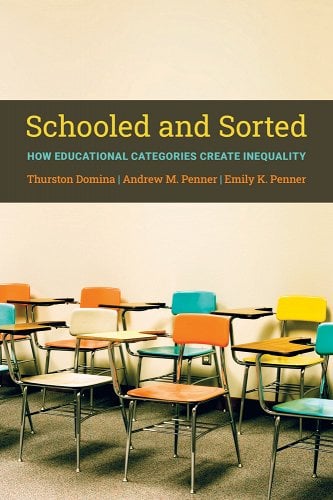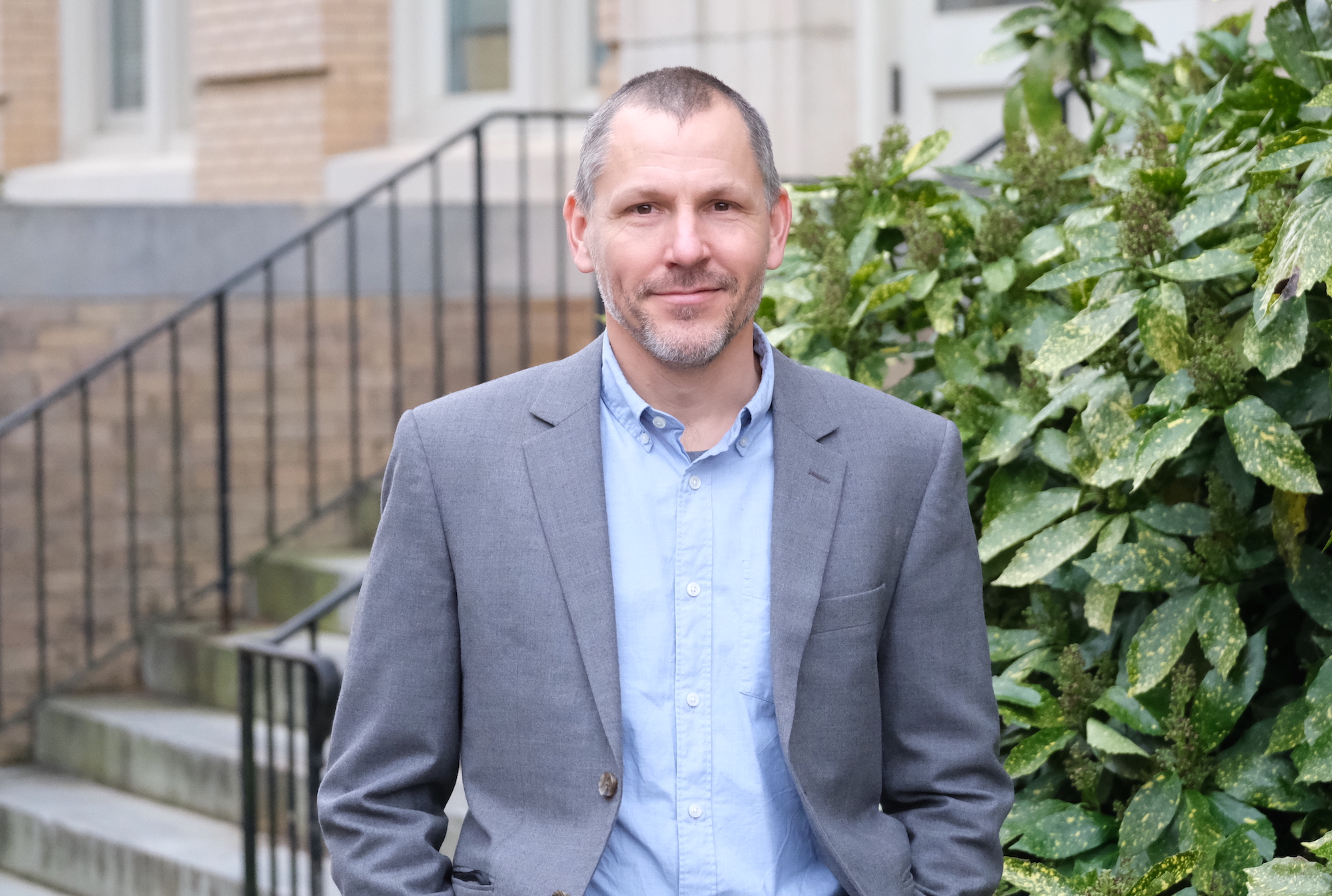For the last 20+ years, Thurston “Thad” Domina, Ph.D., the Robert Wendell Eaves Sr. Distinguished Professor in Educational Leadership, has studied every level of education, utilizing various analytical tools to understand the impact of families, schools, and educational experiences on child development and transition into adulthood. His work continues to report on educational disparities and focuses on educational policies and strategies that promote the development of more equitable communities.
A new book — “Schooled and Sorted: How Educational Categories Create Inequality” — co-authored by Domina and Andrew M. Penner, Ph.D., a professor of sociology at the University of California, Irvine, and Emily K. Penner, Ph.D., an associate professor of education at the University of California, Irvine, explores disparities created by a ubiquitous practice in education — categorization. 
As soon as children enroll into schools, they are placed into categories beginning with “kindergartner.” From there, they might fall into categories such as English language learner, honor roll student, or free lunch recipient, among many others.
In “Schooled and Sorted,” Domina and his co-authors explore processes of educational categorization to explain the complex relationship between education and social inequality — and to identify strategies that can help build more just educational systems.
Below is a Q&A with Domina about the new book — its origins, the harms categorization can cause beyond schooling (and graduation), and more.
What was the impetus for this book? Was there something in particular you were you seeing in your research or in your peers’ research that made this so necessary?
One day, at least 10 years ago, I got a phone call out of the blue from a reporter who had learned about a school that had begun giving students ID cards that were color-coded based on their scores on end-of-grade tests. Students who scored in the highest category on all of their tests got platinum IDs; students who scored in the top two categories on all of their tests got gold IDs; everybody else got white IDs. The school required students to wear these IDs all day long, and the school even created express lunch lines and other goodies to reward students with platinum and gold IDs.
The school’s principal thought he’d come up with a way to give students an incentive to succeed academically – something like the varsity letters that athletes wear on their class jackets. But I worried that those color-coded IDs would create inequalities that would follow kids through their whole lives. I eventually got the chance to study the school, and it turned out that I was right to worry. The kids who got low-status white IDs based on just a single missed question on a test looked worse on a wide range of later outcomes than nearly identical kids who had just eked out a gold ID. And this difference was particularly pronounced for kids of color and kids from low-income families.
That story got me thinking hard about educational categories, which made me realize that much of the work that we do around education and inequality is all about educational categories — classrooms, honor rolls, academic tracks, credentials, and degrees — and the way those categories interact with broader social categories like race and gender. In the book, we argue that understanding those categorical processes is crucial for understanding education as a social institution. We think of schools as places for teaching and learning — and they are. But that’s not all they are. They can’t operate without building categories, and we can’t understand the link between school and social inequality without looking closely at those categories.
Is there a category, perhaps one that on its face appears innocuous and is ingrained in schools and in the public consciousness of schools, that is particularly harmful to students or a particular group of students?
One category that I think a lot about is the category of free lunch students. This is an interesting case because it’s a compassionate impulse that leads our educational system to categorize students at lunchtime. Because we want to make sure that students whose families have low incomes aren’t going hungry, federal policy pays for schools to give free meals to students whose families make less than 130% of poverty and reduced-price meals to students whose families make less than 185% of poverty.
For many kids, these school meals are a lifeline.
But being categorized as a free lunch student also marks a student as poor, often conveying a stigma that they carry with them far beyond the school lunch room. My work suggests that doing away with the category by giving free meals to all students is especially helpful for reducing the chances that kids who would have once been free lunch students get into disciplinary trouble at school.
How does categorization manifest beyond schools?
One of the most powerful ways that educational categories manifest beyond schools is by giving meaning to categories that operate elsewhere in society. Here’s an example of what I’m talking about: At many racially diverse high schools, Black and Hispanic students are often placed into low-track and vocational classes while White and Asian students are often placed into higher-track, advanced classes. This reality is troubling on its face, because it represents an inequality across racial lines in students’ opportunities to learn. But even worse, these racialized tracking practices help to reinforce stereotypes around race and academic achievement. In this way, racialized tracking gives meaning to racial categories.
Categorization is seemingly inextricable from education. How might a school district leader begin to make existing categorizations more equitable?
We argue that the first step is just taking a careful, self-reflexive look at the categories schools create. It’s hard to imagine schools without categories. But if we think carefully about our educational categories and what they’re doing, we open up the possibility to build better and more equitable schools.
There aren’t quick fixes here. It takes an inclusive, community effort to see the harms associated with existing categories and to imagine newer, more equitable educational categories. But here’s one rule of thumb that strikes me as broadly useful: “Low scope” categories — where students are sorted and resorted into different educational environments repeatedly over the course of a day, a school year, or an educational career — are generally more equitable that “higher scope” categories that stick with students. An example of a low-scope sorting system is a school that creates opportunities for students to pick their own courses at several points in an academic year. Such a system allows students to sort and re-sort themselves, giving them the chance to build diverse webs of social connections in the school. Successful low-scope sorting systems provide students with multiple pathways to educational success that respond to their diverse needs and interests.
Are there successes you can point to when it comes to recategorization or to doing away with a particular categorization?
Here’s a historical example that I find telling: In the late 19th century, when American educators were building some of the world’s first freely accessible mass systems of education, many cities operated what were called “monitorial schools.” In these schools, a hundred or more students were arranged in a large room, organized in rows based on their mastery of basic reading and arithmetic skills. Kids started at the back row, and if they demonstrated academic competency, they could move up, row by row, their skills improved. Many students never made it out of the back row, others might slide back if their peers progressed faster than them. But ultimately, if students made it to the front of the room, they could graduate to the position of “monitor,” where they were tasked with helping the students seated in rows.
We don’t have monitorial schools anymore. At some point, that intensely competitive model of education was replaced by the age-graded schools we know today – where 6-year-olds are grouped together in 1st grade, 7-year-olds are grouped together in 2nd grade, and so on. This system strikes me as far more equitable. Even though the 2nd graders get more advanced instruction than the 1st graders, the system has mobility built into it — as you age, you advance. I also like that it’s built around a student characteristic — age — that cut across race, gender, social class, religion, and so many other social fault lines.
I like thinking about the age-graded school because it’s a reminder that we can — and do — create equitable categories in some parts of our educational system. I hope “Schooled and Sorted” both help and challenge educators to build on that success in their contemporary practice.
